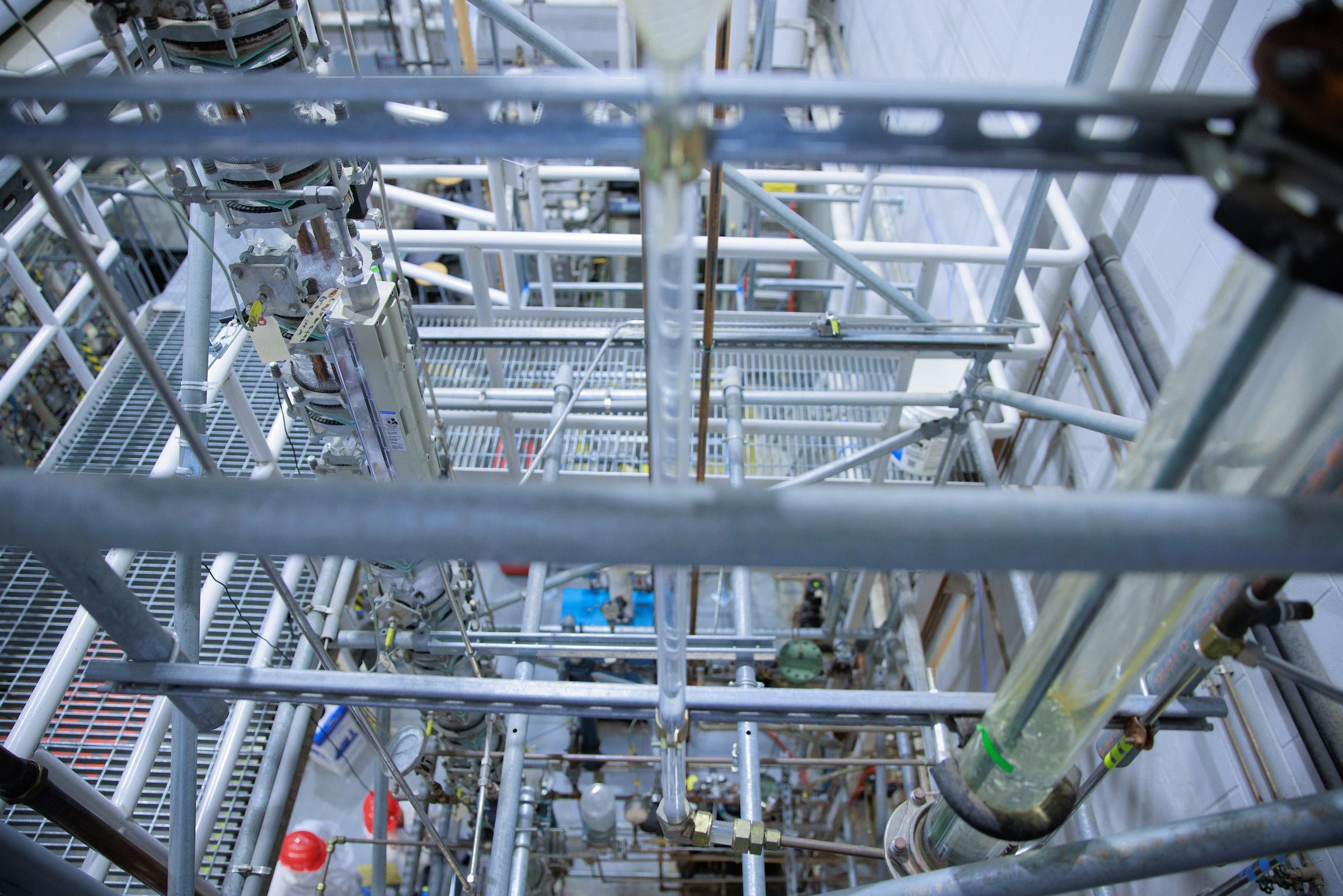Chemical Engineering Distilled
How the College of Engineering uses distillation to solidify chemical engineering concepts

While it's common for college-level chemical engineering laboratories to have some type of distillation unit, it typically doesn't come in the form of a two-story apparatus with 15 sieve trays and five different feed locations. Yet, the Lewis-Texaco distillation column in the Unit Operations Lab at The University of Alabama boasts just that.
Distillation is one of the primary separation methods used in chemical processing in many different industries, from oil refineries to food processing. It is used to concentrate or purify a product by utilizing different boiling points of materials in a mixture.
According to Dr. Stephanie Loveland, chemical and biological engineering professor in the College of Engineering, the distillation column is used to teach the principles of distillation design and operation, safety, gas chromatography, and vapor-liquid equilibrium. The column provides a hands-on learning experience where chemical engineering students can see firsthand how a distillation unit works and reinforce the concepts they learn in their separations course.
Spencer Culotta is a senior chemical engineering major from Bartlett, Illinois. "We do theoretical work and use modeling software in our classes. But actually working with the distillation column and seeing the steam running through the system and the cause and effect as we change variables puts the theoretical numbers into perspective," he said.
In addition to its size, another unique quality of UA's distillation unit is the glass column, which allows students to see what's happening on each tray inside the apparatus in addition to temperature and pressure measurements on the computer screen. They see flooding or weeping of liquids on each tray and the physical effects inside the apparatus as well as in the temperature and pressure measurements. "In industry, columns are constructed of metal and are insulated, so it's not possible to see what is happening on the trays. There are only measurements. In this experiment, students can visualize what is going on and understand better why these phenomena lead to poor separation performance," Loveland said.
Tyler Wilson, a senior chemical engineering major from Tuscaloosa, Alabama, said, "We can run the column at total reflux, meaning we can keep everything in the column. If you change too many things at once, it’ll flood the column. That’s what happened the first time we ran the unit. This time we learned from our mistakes and this second run has been far more successful. You can actually see what’s happening in the clear column. So, when we flooded it, we could visually see it instead of just looking at data on the screen."
Dr. Loveland explaining distillation measurements to students.
Dr. Loveland explaining distillation measurements to students.
Students view the distillation process in real-time through the column's glass wall.
Students view the distillation process in real-time through the column's glass wall.
Ashley Kearney, a senior chemical engineering major from Daphne, Alabama, said, "It's more complicated than we thought. We use modeling to help prep for the use. It’s been surprising to see how different the actual experiment runs in comparison to the model."
Culotta added, "What seems like a very small change can have a significant impact on the circumstances inside the column."
UA students and professors take full advantage of this unique lab with courses running for six hours a day, Monday through Friday. While the column doesn't run every lab day, it can be in operation on any one of those days, depending on need.
Kearney concluded, "I’ve always heard this is the ultimate chemical engineering lab since you’re putting everything you’ve learned into practice. I’ve done a co-op and an internship. Being able to learn with the equipment and run it yourself is so helpful. Running the column yourself is something you don’t typically get to do in a co-op and you learn a lot through the hands-on experience. You think you know what you’re doing when you walk in, but quickly realize it’s more complicated than you thought."
"Being able to say I’ve worked with a distillation column and know how to operate it and what conditions to set it at is a huge advantage," Culotta added.
The final products from the distillation column are almost completely pure water and ethanol up to 95% concentration. "Using this mixture of ethanol and water illustrates the concept of an azeotrope, in which the components cannot be separated further by distillation, because the mixture has reached a point where the liquid and vapor have the same composition," Loveland said.
The question remains: What happens to this extremely pure concentration of ethanol following each experiment? While not very exciting, the answer is ... nothing. Following the completion of each experiment, the water and ethanol are remixed for the next set of experiments.
Dr. Loveland and students examine one of the column's six-inch diameter sieve trays.
Dr. Loveland and students examine one of the column's six-inch diameter sieve trays.
An up-close look at one of the 15 sieve trays in action.
An up-close look at one of the 15 sieve trays in action.





